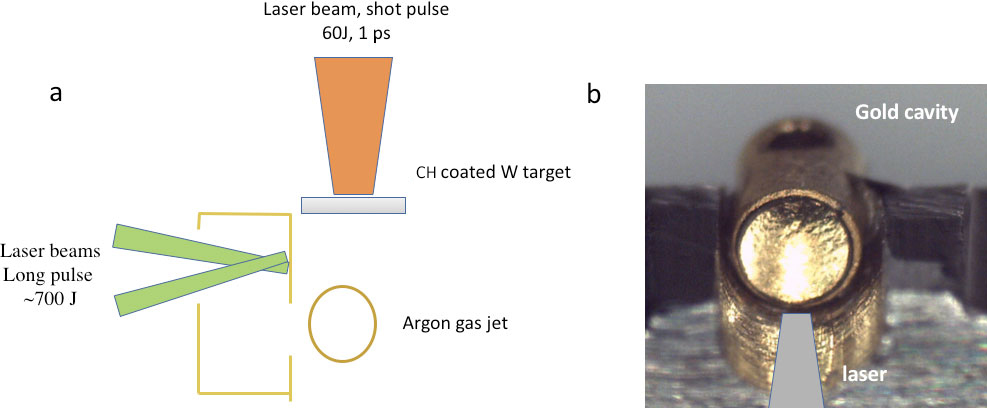Sebastien Le Pape
Overview
The goal of this project was to probe the underlying physics governing the radiation that is generated by accretion disks surrounding black holes, and thus to better understand the physics of black holes. This radiation is emitted by a plasma where radiation is the dominant ionization process, as opposed to laser-generated plasmas in which the dominant ionization process is collisions. Generating a controlled photo-ionized plasma remains an experimental challenge; we chose to use a high-power laser to generate a bright source of photons at a peak emission temperature of ~ 300 eV to photoionize low-density gases (neon and argon). During this project, we developed the simulation tools necessary to analyze the experimental spectra obtained on both neon and argon. We also gathered for the first-time spectra of photoionized neon during an experimental campaign at the Laboratoire pour l'Utilisation des Lasers Intenses (LULI).
The experimental campaign carried out at LULI was successful in producing the first simultaneous measurement of K- and L-shell lines from photoionized argon. The data are in overall agreement with our expectations, but more research needs to be done to fully understand the effect of gas density and x-ray flux on the ionization state of the photo-ionized plasma. In parallel to this experimental research, a large effort has been devoted to developing the simulation tools (hydrodynamic modeling as well as atomic physics codes) needed to better understand the experimental platform and the acquired spectra. The atomic physics simulation shows a fair agreement with the experimental data; we achieved a regime were the photoionization parameter is higher than unity and the highest value inferred comes from the χ2 analysis: ξ = 8.2 erg.cm.s-1, suggesting a radiation-dominated regime.
Background and Research Objectives
The goal of this project was to shed light on the assumption that resonant Auger decay (RAD) is in fact responsible for the absence of the iron Kα-line in the emission spectra of black-hole accretion disks. The immediate environment of black holes offers a unique laboratory for astrophysics. Accretion onto black holes is among the most efficient of astrophysical processes; it is the mechanism behind their prodigious luminosity. In addition, black holes provide an opportunity to explore the strong-field regime of general relativity [GM/(Rc2)]~1, where M and R are the mass and characteristic scale of the gravitational source, respectively. Due to the relatively high abundance of iron in the universe and its efficient production of photons by fluorescence, a set of strong Kα emission lines can be created whenever a strong hard x-ray source is present. In addition, a relativistically broadened profile is an immediate signal of an origin deep in the potential well of the black hole. The iron Kα line complex can give us valuable information about material that is preparing to disappear from the observable universe as it crosses over the event horizon. However, the process of resonant Auger destruction (which combines complex atomic kinetics with radiation transport) and its role in the calculations of relativistic disk models and in interpreting data from accreting black holes is still unclear.
Besides observations and theoretical work, very few laboratory experiments have tackled this complex issue. Previously, we had developed an experimental platform at the LULI facility in France, which allowed us to perform for the first time a precise measurement of the self-emission of an iron-photoionized plasma, thus providing constraints on the efficiency of the resonant Auger destruction process. Because iron gas is toxic, we gathered experimental data on photoionized argon gas instead, using the facilities at the Laboratoire pour l'Utilisation des Lasers Intenses (LULI, Ecole Polytechnique, France) and developed the simulation tools to analyze our experimental data (see figure).
Impact on Mission
This research supports the NNSA mission of advancing the scientific, technological, and engineering competencies that are the foundation of the NNSA mission. Specifically, the information and capabilities resulting from this research will contribute to Lawrence Livermore National Laboratory's core competency in high-energy-density science.
Conclusion
This project is the beginning of a collaboration between Lawrence Livermore National Laboratory, LULI, and CEA (the French Alternative Energies and Atomic Energy Commission). Some questions are still unanswered; for instance, the temperature needed to explain the measured spectra is on the high side of our simulation. Also, a similar analysis still needs to be made for the argon case. For these reasons, we are evaluating the viability of developing such an experimental platform on the National Ignition Facility. The ability to study K-shell lines in iron would enable a direct comparison to accretion disk spectra.






